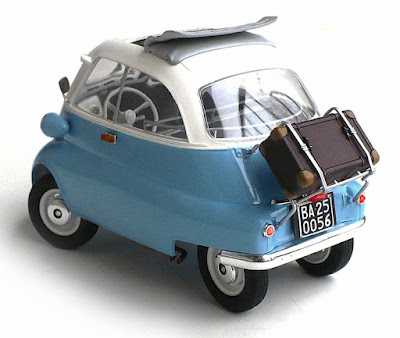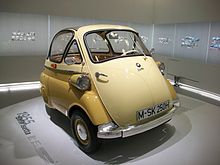From Wikipedia"
The Isetta is an Italian-designed microcar built under license in a number of different countries, including Spain, Belgium, France, Brazil, Germany, and the United Kingdom. Because of its egg shape and bubble-like windows, it became known as a bubble car, a name later given to other similar vehicles.
In 1955, the BMW Isetta became the world's first mass-production car to achieve a fuel consumption of 3 L/100 km (94 mpg‑imp; 78 mpg‑US). It was the top-selling single-cylinder car in the world, with 161,728 units sold.
Initially manufactured by the Italian firm Iso SpA, the name Isetta is the Italian diminutive form of ISO, meaning little ISO.
BMW made the Isetta its own. They redesigned the powerplant around a BMW one-cylinder, four-stroke, 247 cc motorcycle engine which generated 10 kW (13 hp). Although the major elements of the Italian design remained intact, BMW re-engineered much of the car, so much so that none of the parts between a BMW Isetta Moto Coupe and an Iso Isetta are interchangeable. The first BMW Isetta appeared in April 1955.
1955 BMW Isetta 250, BMW Museum, Munich, Germany
While it retained the "Bubble Window" styling, it differed from the Italian model in that its headlamps were fixed separately to the sides of the bodywork and it carried the BMW badge below the windscreen. The car was also redesigned to take a modified version of the 250 cc four-stroke engine from the BMW R25/3 motorcycle and the front suspension was changed. The single-cylinder generated 9 kW (12 hp) at 5800 rpm. The crankcase and cylinder were made of cast iron, the cylinder head of aluminium. However, the head was rotated by 180° compared with the motorcycle engine. The twin-bearing crankshaft was also different in the Isetta power unit, being larger and featuring reinforced bearings. One of the reasons for this was the heavy Dynastart unit which combined the dynamo and self-starter. The fuel mixture was provided by a Bing sliding throttle side draft motorcycle carburetor. In addition to further changes of detail, the BMW engineers enlarged the sump for installation in the car and cooled the engine by means of a radial fan and shrouded ducting.
The power train from the four-speed gearbox to the two rear wheels was also unusual: fixed to the gearbox output drive was something called a Hardy disc, which was a cardan joint made of rubber. On the other side of it was a cardan shaft, and finally a second Hardy disc, which in turn was located at the entrance to a chain case. A duplex chain running in an oil bath led finally to a rigid shaft, at each end of which were the two rear wheels. Thanks to this elaborate power transfer, the engine-gearbox unit was both free of tension and well soundproofed in its linkage to the rear axle.
In Germany, the Isetta could even be driven with a motorcycle license. The top speed of the Isetta 250 was rated as 85 km/h (53 mph).
The first BMW Isetta rolled off the line in April 1955, and in the next eight months some 10,000 of the "bubblecars" were produced.









4 comments:
That would be freaky to drive, what do you do when you have a head on??? Oh and if you survive that is...lol
Cool looking model.
Thanks Shayne! Probably no more protection than a motorcycle and at half the speed.
Pretty model, correctly sedan :)
Brilliant idea, congratulation.
These have a lot of time with me adolescence
and 3-wheeled Messerschmitt.
It was the right Messerschmitt cab
and the wing stubs, motorcycle engine
After the war, cars were expensive, and western cars must buy (import) hard currency
Today: I think the British still manufactures Reliant (some type) vechiles
Thanks Maximex - Heinkel made these types of cars as well after the war.
Post a Comment